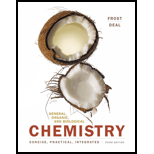
Concept explainers
a.
To draw:
The structure of leucine and mark an asterisk (*) next to any chiral carbon centers.
Introduction:
Amino acids are the integral components of a protein molecule. Amino acids contain a protonated
b.
To determine:
The structure of glutamate and mark an asterisk (*) next to any chiral carbon centers.
Introduction:
Amino acids are the integral components of a protein molecule. Amino acids contain a protonated amine and a carboxylic acid in the form of carboxylate ion. These two functional groups are bonded to a central carbon atom called the alpha-carbon. The protonated amine bonded to this carbon is called alpha-amino group and the carboxylate ion as the alpha carboxylate group. The alpha-carbon is also bonded to a hydrogen atom and a larger side chain designated as R, which gives unique identification and characteristics to each amino acids.
c.
To determine:
The structure of methionine and mark an asterisk (*) next to any chiral carbon centers.
Introduction:
Amino acids are the integral components of a protein molecule. Amino acids contain a protonated amine and a carboxylic acid in the form of carboxylate ion. These two functional groups are bonded to a central carbon atom called the alpha-carbon. The protonated amine bonded to this carbon is called alpha-amino group and the carboxylate ion as the alpha carboxylate group. The alpha-carbon is also bonded to a hydrogen atom and a larger side chain designated as R, which gives unique identification and characteristics to each amino acids.
d.
To determine:
The structure of threonine and mark an asterisk (*) next to any chiral carbon centers.
Introduction:
Amino acids are the integral components of a protein molecule. Amino acids contain a protonated amine and a carboxylic acid in the form of carboxylate ion. These two functional groups are bonded to a central carbon atom called the alpha-carbon. The protonated amine bonded to this carbon is called alpha-amino group and the carboxylate ion as the alpha carboxylate group. The alpha-carbon is also bonded to a hydrogen atom and a larger side chain designated as R, which gives unique identification and characteristics to each amino acids.
Want to see the full answer?
Check out a sample textbook solution
Chapter 10 Solutions
General, Organic, and Biological Chemistry Plus Mastering Chemistry with Pearson eText - Access Card Package (3rd Edition)
- Drawing Peptide Structures Draw the tripeptide that would result from cysteine attaching to the previous dipeptide on the acidic side.arrow_forwardIdentifying Amino Acids Which of the following molecules is an amino acid?arrow_forwardWhat types of interactions can occur between the side chains of the following amino acids that would help maintain the tertiary structure of a protein? a. cysteine and cysteine b. glutamine and serine c. glutamic acid and lysine d. proline and leucinearrow_forward
 ChemistryChemistryISBN:9781305957404Author:Steven S. Zumdahl, Susan A. Zumdahl, Donald J. DeCostePublisher:Cengage Learning
ChemistryChemistryISBN:9781305957404Author:Steven S. Zumdahl, Susan A. Zumdahl, Donald J. DeCostePublisher:Cengage Learning Chemistry: An Atoms First ApproachChemistryISBN:9781305079243Author:Steven S. Zumdahl, Susan A. ZumdahlPublisher:Cengage Learning
Chemistry: An Atoms First ApproachChemistryISBN:9781305079243Author:Steven S. Zumdahl, Susan A. ZumdahlPublisher:Cengage Learning
 World of Chemistry, 3rd editionChemistryISBN:9781133109655Author:Steven S. Zumdahl, Susan L. Zumdahl, Donald J. DeCostePublisher:Brooks / Cole / Cengage Learning
World of Chemistry, 3rd editionChemistryISBN:9781133109655Author:Steven S. Zumdahl, Susan L. Zumdahl, Donald J. DeCostePublisher:Brooks / Cole / Cengage Learning
 World of ChemistryChemistryISBN:9780618562763Author:Steven S. ZumdahlPublisher:Houghton Mifflin College Div
World of ChemistryChemistryISBN:9780618562763Author:Steven S. ZumdahlPublisher:Houghton Mifflin College Div





